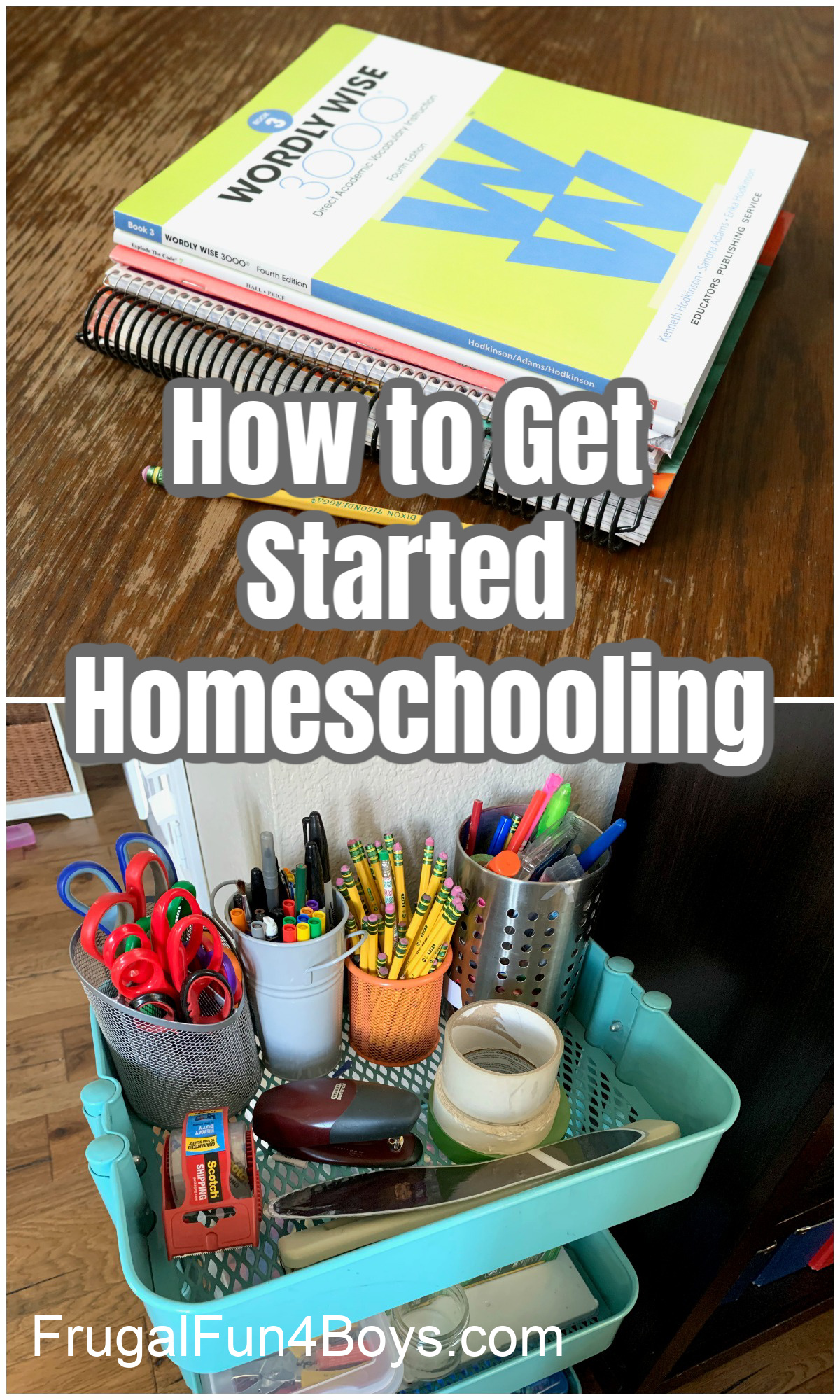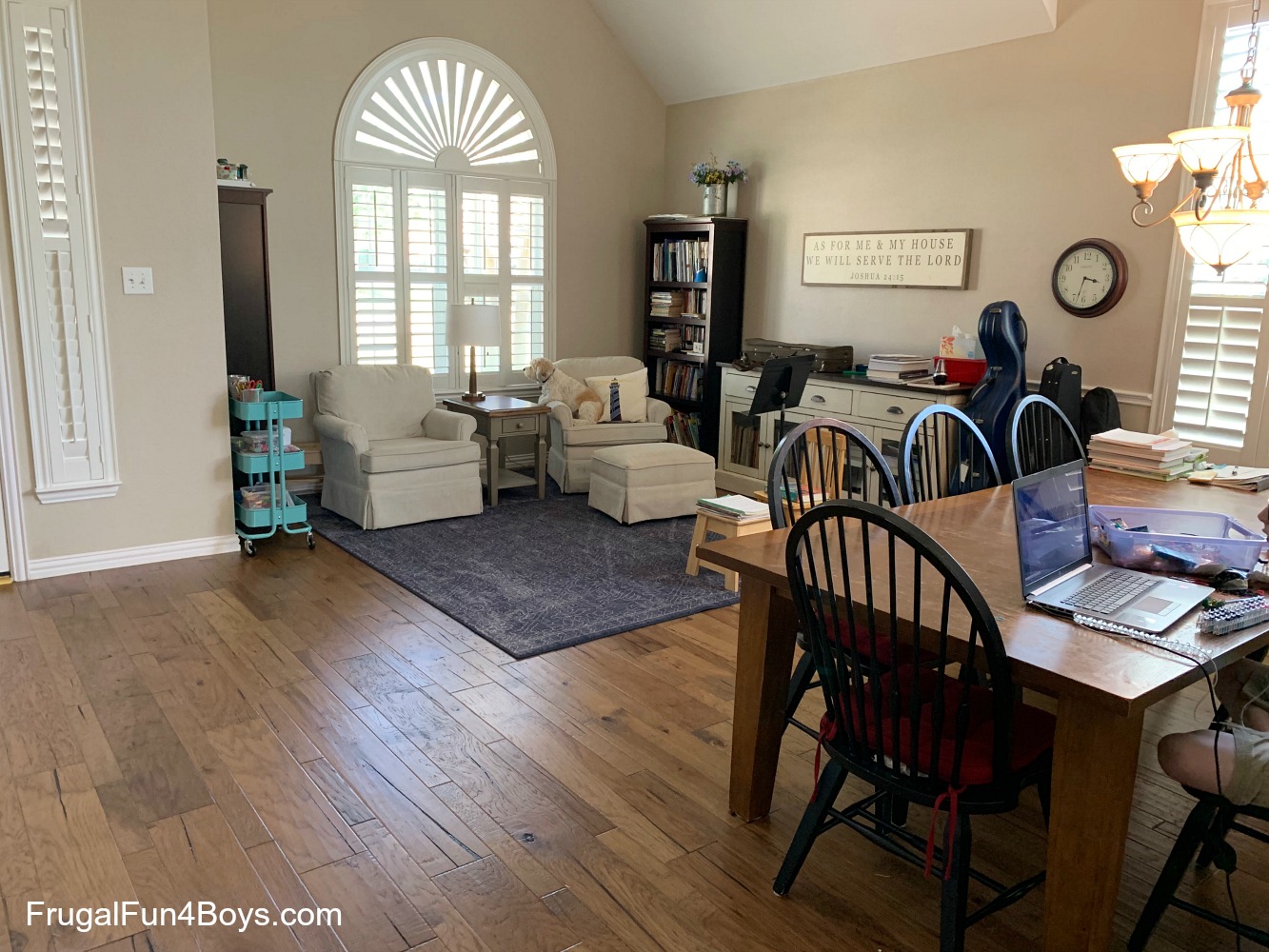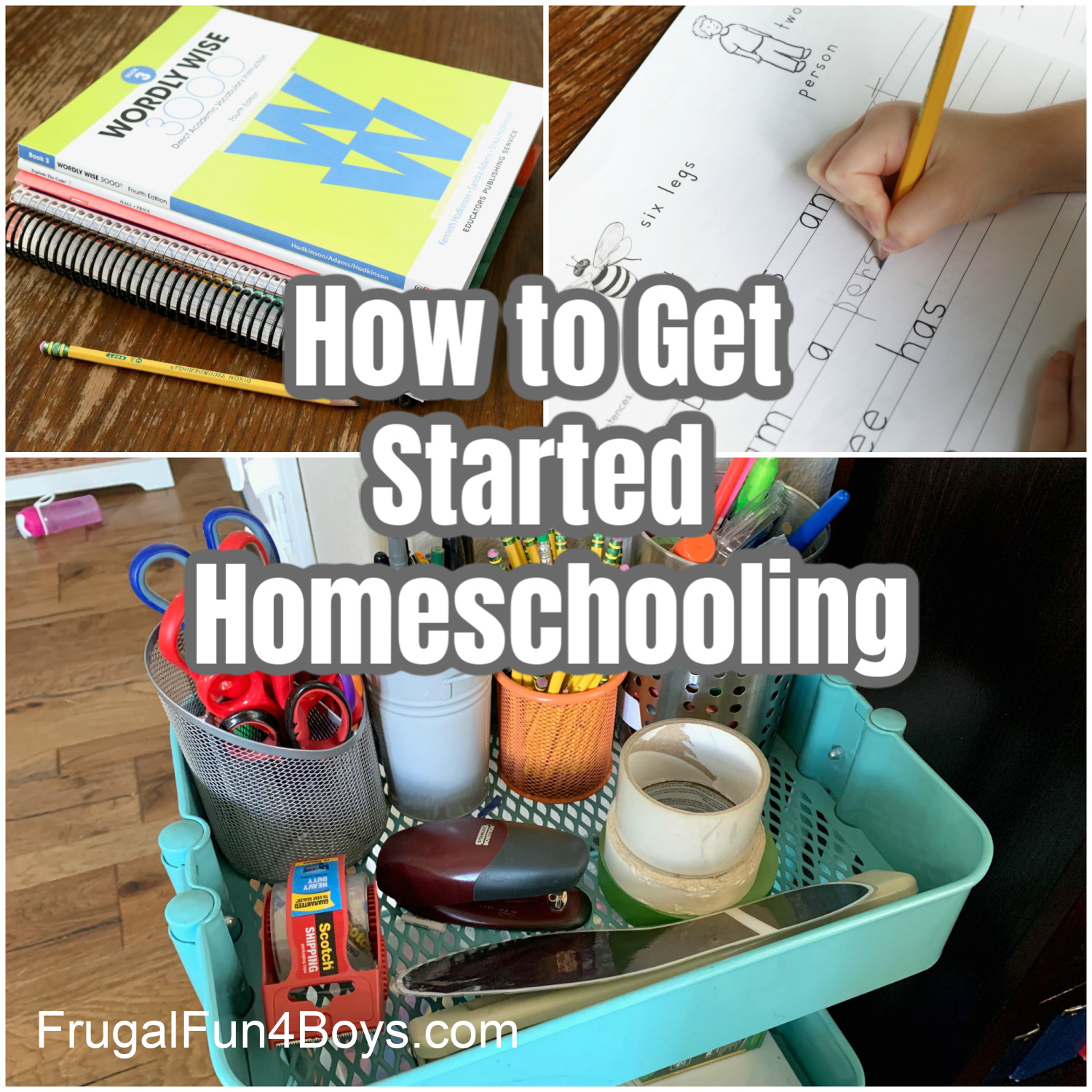This post is part 2 in our series on getting started with homeschooling. In the first post, we looked at making the decision to homeschool, but this time I want to talk about how to actually get started once you’ve made the decision to homeschool.
Here’s what we’ll cover:
- Pulling your child out of school
- Choosing a curriculum
- Setting up a work space at home
- Creating a routine that works for you

Starting to Homeschool – Pulling Your Child out of School
Whether your kids have been attending public school or you are just starting out with kindergarten, you’ll need to find out what the legal requirements are for homeschooling in your state. Spoiler: Some states are much more homeschool-friendly than others! Head over to the HSLDA website to find out the requirements for your state. Scroll down to the bottom of the page and click on “Homeschool Laws by State.”
Choosing a Curriculum
Curriculum is a topic that is too big to cover with a blog post, and I’m attempting to talk about it in just part of a post. So know that I’m just scratching the surface here!
There are so many options for curriculum. Part of your decision will depend on what you found out about homeschooling laws in your state. In Texas, we can choose whatever curriculum we want.
We use a mix of Christian and secular curriculum. If you prefer to go with all secular, there are plenty of choices!
Attending a homeschool convention or book fair is a great way to look through curriculum and see if you like it. Unfortunately, those types of events are not happening this year with the pandemic.
I like to order books and materials from Rainbow Resource, Christian Book Distributors, and Mardel. And of course, Amazon!
History/Literature
For the 2020-2021 school year, we’ll be doing Sonlight Core D (American History) with my 1st, 3rd, and 6th graders. This will include literature selections as well.
Language Arts
My first grader will be doing Explode the Code phonics (she’s in book 3 currently), Handwriting without Tears, and Wordly Wise B. Wordly Wise is a vocabulary series. They have a new first grade book, but I don’t like it.
My third grader will be doing Handwriting without Tears, Wordly Wise 3rd Grade, and Rod and Staff Grammar 3rd grade.
My sixth grader will be doing Wordly Wise 6th grade, Rod and Staff Grammar 6th grade, and Reading Detective.
Reading Detective (from The Critical Thinking Co.) is a great resource for improving reading comprehension. It teaches kids to make inferences, draw conclusions, analyze a character’s actions, etc, and then back up their answers with proof from the text.
We’ll also be doing various writing assignments to go with our history studies.
Math
My first grader is also doing a brand new math series – Apologia 1st grade math.
I haven’t decided yet what my 3rd grader is doing for math…
My 6th grader will be doing Making Math Meaningful from Cornerstone Curriculum. We’ll be adding extra drill with Rod and Staff 6th grade math.
Science
We will be doing one of the Young Explorers books from Apologia, but I haven’t decided which one yet. Probably botany or astronomy, or maybe both. My younger 3 will all do the same science. However, I have my 6th grader do his reading and journal work on his own since he can move at a faster pace.

Curriculum Tips:
- You’ll probably need to learn what curriculum works for you through trial and error… I know we did!
- Some programs are scripted (tell you exactly what to say to your child) while others give learning objectives for each lesson. This is mainly in the early grades. Personally, I don’t prefer scripted curriculum. I’d rather do my own thing! This is a matter of personal preference that you’ll want to watch for as you select curriculum.
- If you’re just getting started, you may want to go with an all-in-one curriculum that covers every subject. You can branch out later once you’ve gotten the hang of doing school at home.
- Don’t be afraid to make a change mid-year if what you’ve chosen just isn’t working!
- Find local friends to talk to about curriculum, or join a homeschooling Facebook group where you can ask questions. Two I would recommend are “It’s Not That Hard to Homeschool K-8” and “It’s Not That Hard to Homeschool High School.” My good friend Ann runs both groups, and she has a great moderator team that keeps the groups helpful and low on drama.
For preschool curriculum, head over to this post: Getting Started with Preschool at Home
Setting up a Work Space in Your Home
Homeschooling can work in any space! At our first house, we worked at the kitchen table, which was our only table. We had to put everything away at meal times. We stored our materials on the built-in shelves in our laundry room, and it worked just fine!
At our second house, we had a dedicated school room that was actually a formal dining room.
At our current house, we have a formal living room that we use for homeschooling and instrument practice. We do our work at the table in the same room. We eat at a different table in the kitchen. Here’s a photo of our current set-up:

We store most of our books in the two tall bookshelves, one on either side of the room. The turquoise IKEA cart holds pencils, pens, scissors, glue, tape, index cards, crayons, and math manipulatives. The large white cabinet has my violin case on top, and the cupboards are full of sheet music, the laminator, and more homeschool materials – magnetic letters, lacing cards, etc.
I also recently bought an IKEA bookcase for our closet under the stairs. It’s a full sized bookcase, and it holds a ton! I’m using it to organize more chapter books and curriculum that we are not currently using.
I like having our homeschool room as a main room in our house because it can’t get too messy! Well, it CAN, but then we have to clean it up because it’s right by the front door. Keeps us accountable, haha!
Some families use a game room as a school space. Some use desks instead of a table. I prefer a table so that I can work with more than one child at a time, but truly it needs to be whatever setup is best for you!
Creating a Routine that Works for You
We have never had a strict schedule because we don’t always spend the same amount of time on each subject. What works for us is a daily routine and weekly assignment sheets.
On Sundays, I fill in the assignment sheets for the week.
Then, you can read about our daily routine in this post that I wrote just a few months ago – Creating a Homeschool Routine.
Here’s a post that I wrote about our Daily Homeschool Routine with Multiple Young Kids – the kids were all 10 and under at this point.
If you’re just jumping in on this post, be sure to check out the rest of the series!
Part 1 – Getting Started Homeschooling: Making the Decision
Part 2 – Getting Started Homeschooling: Where to Begin (this post)
Part 3: Balancing Homeschooling with the REST of Life (I’ll add the link once this one is live!)


5 Comments
Mandy Baxter Jul 6, 2020
Do you have recommendations for homeschooling with a pre-preschooler at home too? I have a soon to be 6th grader, 3rd grader, and 2 yr old! This would be our first time homeschooling.
Vicki Kammerer Jul 7, 2020
Sarah, what a wealth of information you are! I have been following you for years for fun activities to do with kiddos. Tonight, I spent two hours pouring over your posts on homeschooling. Next time, I am gonna have to read with pen and paper in hand. Thank you so much!
Tilly Morrison Jul 10, 2020
Hi Sarah,
I might have to homeschool my grandkids who will be a Kindergartner, 1st, 2nd, 4th, and 5th graders. I go to school full-time, and they get up later in the morning and to bed much later at night due to the parent's work schedule. I was wondering if you could help me with a schedule that would help both the parents, children and myself, since I will be doing most of the work with the children.
Thank you.
'Tilly Morrison
Beth Ferguson Jul 12, 2020
Sarah-Thank you so much for posting this information. I am really on the fence with making the decision to home school my son. He will be going into 7th grade. We, too, live in Texas. If I am reading the information correctly, homeschool students in Texas are not required to take the STAAR. Do you personally give your children some sort of assessment to see how they are doing? Is there something for homeschool students? Thank you again. These articles have been extremely helpful.
Sarah Jul 15, 2020
We have taken the Iowa test at our church's co-op, and that has worked well. You can also go through Bob Jones University to administer achievement test at home. It's easy to do, and I think it's helpful to do a test every other year or so!
Holly Jul 27, 2020
Thanks so much for all this information. My kids are 9, 7, and 3, and we are homeschooling due to the Covid19 shutdown, though we never intended to. I feel so out of my element! It is great to read your post and get a sense of the general structure, so I don't feel as helpless and hopeless. Thank you!
Post a Comment